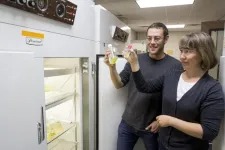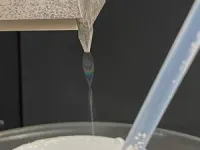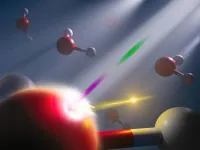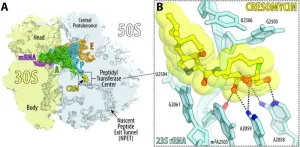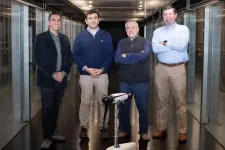(Press-News.org) Researchers at Michigan State University and the Carnegie Institution for Science have developed a model that connects microscopic biology to macroscopic ecology, which could deepen our understanding of nature’s laws and create new opportunities in ecosystem management.
Reporting in the journal Science on Feb. 16, the team showed how microscopic relationships in plankton — such as between an organism’s size and nutrient consumption — scales up to predictably affect food webs.
“Using data that other researchers have measured at the microscale about these organisms, our model can predict what’s happening at the scale of whole ecosystems,” said Jonas Wickman, a postdoctoral research associate with MSU’s College of Natural Science and first author of the new paper.
“We can now show how lower-level rules of life feed into these higher levels based on ecological interactions and evolutionary considerations,” said Elena Litchman, a senior staff scientist at Carnegie's Biosphere Sciences and Engineering division. “Up until now, people had mostly considered these levels in isolation.”
This new report will enable the team and its peers to design new experiments to test, refine and expand the model by extending it to other species and ecosystems. This could ultimately lead to the model being able to inform ecosystem management strategies in various environments around the globe.
Small organisms, global impact
The team is also interested in what more they can learn from their model and the plankton they study.
“We chose them as a model system for a few reasons,” said Christopher Klausmeier, an MSU Research Foundation Professor at the W. K. Kellogg Biological Station. He’s also a faculty member with the Department of Plant Biology, the Department of Integrative Biology and the Ecology, Evolution and Behavior, or EEB, program at MSU.
One of the reasons is that plankton are the primary research focus for the research group led by Litchman and Klausmeier.
“They’re relatively simple organisms. If anything is going to follow the rules, plankton are a good candidate,” Klausmeier said. “But they’re also globally important. They’re responsible for about half of the primary production on Earth and are the base of most aquatic food webs.”
Primary producers use biochemical processes such as photosynthesis to turn the Earth’s carbon and raw nutrients into compounds that are useful for the organisms themselves and their predators. This means plankton are a critical cog in the natural machinery that cycles the planet’s life-essential elements, including carbon, nitrogen and oxygen.
Having this scaling model that describes plankton can thus be useful for better understanding those key processes, as well as if and how those are changing with the planet’s climate.
The team did not include climate-associated variables like temperature in this study, but the researchers are already planning their next steps in that direction.
“The effects of global warming could alter the lower-level physiological processes,” Litchman said. “We could then use this framework to see how those effects bubble up to different levels of organization.”
Eye-popping simplicity
Wickman hasn’t always been a plankton ecologist. His undergraduate degree was in physics, but he switched to ecology during his doctoral studies in Sweden before joining the Klausmeier-Litchman lab in 2020.
The team said his physics background shaped his approach to developing this model, which Litchman described as “beautiful — stripping out everything except the essential processes.”
To begin, Wickman built from fundamental theories describing his system of interest. Only in this case, the system wasn’t, say, quantum mechanical particles. It was tiny organisms linked by a simple food web.
Within that web, phytoplankton are the primary producers and zooplankton are their predators.
“Well, grazers really,” Wickman said of the zooplankton. “We don’t usually call cows predators of grass.”
To fully appreciate the workings of this important relationship and its global implications, researchers have been breaking it down into its components driven by ecology and evolution.
For example, microscopic considerations like the size of a phytoplankton affect its ability to compete for nutrients, which in turn influence how big cells can get and how likely it is to become food for zooplankton.
These microscopic factors are thus connected to macroscopic variables, including the distribution of nutrients and how densely or sparsely different plankton populate their environments.
Over the past several decades, scientists have formulated mathematics that describe important relationships at the micro scale and macro scale individually. Attempts to bridge the scales, however, have left researchers wanting, Wickman said.
That’s because previous attempts to make that connection have had to make compromises. Some previous models have chosen simplicity at the expense of accuracy and realism. Others have confronted that complexity with brute computational force, making them less accessible and harder to work with.
“Our model includes actual ecological and evolutionary mechanisms but is simple enough to use,” Wickman said.
The work began as pure theory, but Litchman suggested that it should be possible to test its predictions using existing data. “When I saw how well the model matched the observations, my eyes popped out,” she said.
With support from the U.S. National Science Foundation, or NSF, the team had been working on this problem for several years and had published an earlier paper developing the eco-evolutionary modeling techniques they relied on.
Now, the team has showcased the potential of their model by uniting it with real-world data.
“The revelation that patterns emerging at macroecological scales can be explained by properties of individual organisms at microecological scales is as compelling as it is elegant,” said Steve Dudgeon, program director in NSF’s Directorate for Biological Sciences, which helped fund the work.
“The study provides new avenues of research that could enhance prediction of how ecosystems, and the relationships among the organisms in them, will change with eco-evolutionary dynamics interacting in changing environments.”
Because of the natural variation of biological systems, the model and its results may seem messy to someone used to the precision of physics, but Wickman views them with excitement.
“We actually achieved quite good accuracy for ecology,” he said. “We may not have the same level of theoretical elegance as physics, but that just means we have much more territory to explore.”
END
MSU, Carnegie Science introduce a big new idea with the help of tiny plankton
A new model bridges the rules of life at the individual scale and the ecosystem level, which could open new avenues of exploration in ecology, global change biology, and ultimately ecosystem management
2024-02-15
ELSE PRESS RELEASES FROM THIS DATE:
First-ever atomic freeze-frame of liquid water
2024-02-15
RICHLAND, Wash.—In an experiment akin to stop-motion photography, scientists have isolated the energetic movement of an electron while “freezing” the motion of the much larger atom it orbits in a sample of liquid water.
The findings, reported today in the journal Science, provide a new window into the electronic structure of molecules in the liquid phase on a timescale previously unattainable with X-rays. The new technique reveals the immediate electronic response when a target is hit with an X-ray, an important step in understanding the effects of radiation exposure on objects and people.
“The chemical reactions induced by radiation ...
Superbug killer: New synthetic molecule highly effective against drug-resistant bacteria
2024-02-15
A new antibiotic created by Harvard researchers overcomes antimicrobial resistance mechanisms that have rendered many modern drugs ineffective and are driving a global public health crisis.
A team led by Andrew Myers, Amory Houghton Professor of Chemistry and Chemical Biology, reports in Science that their synthetic compound, cresomycin, kills many strains of drug-resistant bacteria, including Staphylococcus aureus and Pseudomonas aeruginosa.
“While we don’t yet know whether cresomycin and drugs like it are safe ...
With just a little electricity, MIT researchers boost common catalytic reactions
2024-02-15
CAMBRIDGE, MA — A simple technique that uses small amounts of energy could boost the efficiency of some key chemical processing reactions, by up to a factor of 100,000, MIT researchers report. These reactions are at the heart of petrochemical processing, pharmaceutical manufacturing, and many other industrial chemical processes.
The surprising findings are reported today in the journal Science, in a paper by MIT graduate student Karl Westendorff, professors Yogesh Surendranath and Yuriy Roman-Leshkov, and two others.
“The results are really striking,” says Surendranath, a professor of chemistry ...
Keeping telomerase in check
2024-02-15
The natural ends of chromosomes appear alarmingly like broken DNA, much as a snapped spaghetti strand is difficult to distinguish from its intact counterparts. Yet every cell in our bodies must have a way of differentiating between the two because the best way to protect the healthy end of a chromosome also happens to be the worst way to repair damaged DNA.
Consider the enzyme telomerase, which is responsible for maintaining protective telomeres at the natural ends of chromosomes. Were telomerase to seal off a broken strand of DNA with a telomere, it would prevent further repair of that break and delete essential genes. Now, a new study in Science describes how cells avoid ...
Competition for food drives the planet’s remaining mass migration of herbivores
2024-02-15
Upending the prevailing theory of how and why multi-species mass-migration patterns occur in Serengeti National Park, researchers from Wake Forest University have confirmed that the millions-strong wildebeest population pushes zebra herds along in competition for the most nutrient-dense grasses.
The study resulting from this research, “Interplay of competition and facilitation in grazing succession by migrant Serengeti herbivores,” appears today in the peer-reviewed journal Science.
For decades, biologists have believed the major grazing ...
UT Dallas Wind Energy Center to expand with new headquarters, resources
2024-02-15
The University of Texas at Dallas’ wind energy research programs have expanded rapidly in recent years, with labs, offices and facilities spread out on campus. In 2020 UT Dallas formed the Wind Energy Center, called UTD Wind, to bring its wind energy programs under one virtual umbrella.
Now, a new initiative will give UTD Wind a physical headquarters for the first time with additional labs, meeting areas and office space. The project also includes additional equipment for wind energy research and education.
UT Dallas has received $1.6 million through the federal Consolidated Appropriations Act to support the expansion, which will bring most of the center’s ...
More Aston University scholarships to encourage graduates from under-represented groups to work in artificial intelligence
2024-02-15
• Eleven scholarships worth £10k each for MSc Applied AI
• They are funded by the Office for Students (OfS)
• Aimed at graduates without a science, tech, engineering or maths degree.
Aston University is offering more opportunities to graduates who want a career in artificial intelligence (AI) but don’t have a science, technology, engineering or maths degree.
The scholarships are offered due to increased funding from the Office for Students (OfS). Each award is worth £10,000 and will be awarded to students enrolling ...
How is deforested land in Africa used?
2024-02-15
Africa's forested areas – an estimated 14 % of the global forest area – are continuing to decline at an increasing rate – mostly because of human activities to convert forest land for economic purposes. As natural forests are important CO2 and biodiversity reservoirs, this development has a significant impact on climate change and effects the integrity of nature. To intervene in a targeted manner in the interests of climate protection and biodiversity, there has been a lack of sufficiently good data and detailed knowledge ...
Studies with more diverse teams of authors get more citations
2024-02-15
Diverse research is more impactful in the business management field, with female influence growing stronger in the past decade, finds a new study from the University of Surrey.
The study analysed all articles published in the last 10 years (January 2012 to December 2022) in the influential Journal of Management Studies.
The empirical analysis examined three key aspects of teams’ diversity:
Internationality (how international is mix of authors),
Interdisciplinarity (how many different fields of study they come from),
Gender ...
UC Irvine researcher co-authors ‘scientists’ warning’ on climate and technology
2024-02-15
Irvine, Calif., Feb. 15, 2024 – Throughout human history, technologies have been used to make peoples’ lives richer and more comfortable, but they have also contributed to a global crisis threatening Earth’s climate, ecosystems and even our own survival. Researchers at the University of California, Irvine, the University of Kansas and Oregon State University have suggested that industrial civilization’s best way forward may entail embracing further technological advancements but doing so with greater awareness of their potential drawbacks.
In a paper titled “Scientists’ Warning on Technology,” published recently in the Journal of Cleaner ...
LAST 30 PRESS RELEASES:
Research alert: Spreading drug costs over the year may ease financial burden for Medicare cancer patients
Hospital partnership improves follow up scans, decreases long term risk after aortic repair
Layered hydrogen silicane for safe, lightweight, and energy-efficient hydrogen carrier
Observing positronium beam as a quantum matter wave for the first time
IEEE study investigates the effects of pointing error on quantum key distribution systems
Analyzing submerged fault structures to predict future earthquakes in Türkiye
Quantum ‘alchemy’ made feasible with excitons
‘Revoice’ device gives stroke patients their voice back
USF-led study: AI helps reveal global surge in floating algae
New method predicts asthma attacks up to five years in advance
Researchers publish first ever structural engineering manual for bamboo
National poll: Less than half of parents say swearing is never OK for kids
Decades of suffering: Long-term mental health outcomes of Kurdish chemical gas attacks
Interactional dynamics of self-assessment and advice in peer reflection on microteaching
When aging affects the young: Revealing the weight of caregiving on teenagers
Can Canada’s health systems handle increased demand during FIFA World Cup?
Autistic and non-autistic faces may “speak a different language” when expressing emotion
No clear evidence that cannabis-based medicines relieve chronic nerve pain
Pioneering second-order nonlinear vibrational nanoscopy for interfacial molecular systems beyond the diffraction limit
Bottleneck in hydrogen distribution jeopardises billions in clean energy
Lung cancer death rates among women in Europe are finally levelling off
Scientists trace microplastics in fertilizer from fields to the beach
The Lancet Obstetrics, Gynecology, & Women’s Health: Taking paracetamol during pregnancy does not increase risk of autism, ADHD or intellectual disabilities, confirms new gold-standard evidence review
Taking paracetamol during pregnancy does not increase risk of autism, ADHD or intellectual disabilities
Harm reduction vending machines in New York State expand access to overdose treatment and drug test strips, UB studies confirm
University of Phoenix releases white paper on Credit for Prior Learning as a catalyst for internal mobility and retention
Canada losing track of salmon health as climate and industrial threats mount
Molecular sieve-confined Pt-FeOx catalysts achieve highly efficient reversible hydrogen cycle of methylcyclohexane-toluene
Investment in farm productivity tools key to reducing greenhouse gas
New review highlights electrochemical pathways to recover uranium from wastewater and seawater
[Press-News.org] MSU, Carnegie Science introduce a big new idea with the help of tiny planktonA new model bridges the rules of life at the individual scale and the ecosystem level, which could open new avenues of exploration in ecology, global change biology, and ultimately ecosystem management
